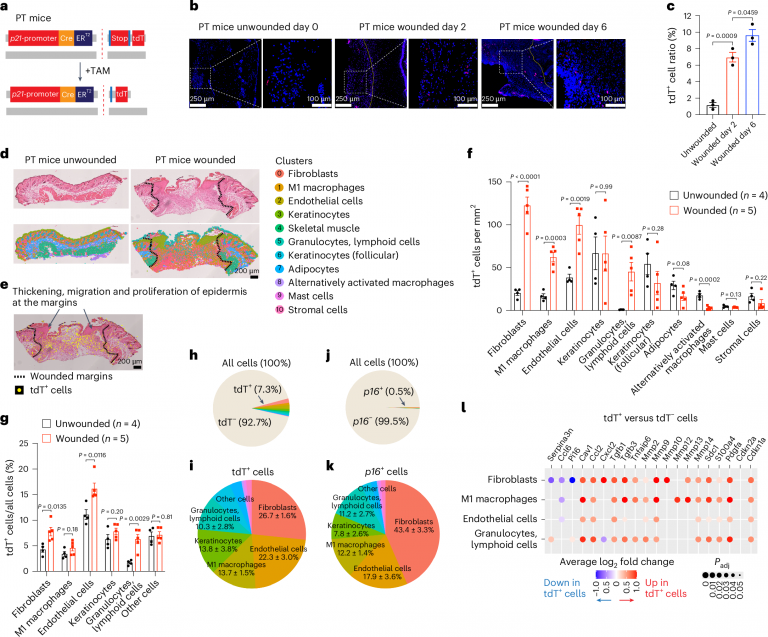Uncategorized Friday, 2024/12/20
Extending lifespan by eliminating aging inflammatory cells is a tempting idea, but scientists in the field of anti-aging suspect that it is too simplistic. Now, in a new study, researchers from the University of Connecticut have confirmed that as age increases, inflammatory cells become diverse, some of which play important roles in the body.
The relevant research results were published online in the journal Nature Aging, with the title “Clearance of p21 highly expressing senescent cells accelerates cutaneous wound healing”.
Our Related Proteins
| Cat.No. # | Product Name | Source (Host) | Species | Tag | Protein Length | Price |
|---|---|---|---|---|---|---|
| CDKN2A-655H | Recombinant Human CDKN2A protein | E.coli | Human | Non | 167 |
|
| CDKN2A-7704H | Recombinant Human CDKN2A protein, His & T7-tagged | E.coli | Human | His&T7 | Ser8~Asp156 |
|
| Cdkn1a-1774M | Recombinant Mouse Cdkn1a protein, His-tagged | E.coli | Mouse | His | Ser2~Pro159 |
|
| CDKN2A-3720H | Recombinant Human CDKN2A protein, GST-tagged | E.coli | Human | GST | 55-156 aa | |
| CDKN1A-3186H | Recombinant Human CDKN1A protein, His-tagged | E.coli | Human | His | 72-164 aa | |
| CDKN1A-2680H | Recombinant Human CDKN1A protein, GST-tagged | E.coli | Human | GST | 2-164aa |
|
| CDKN1A-567H | Recombinant Human CDKN1A Protein, His (Fc)-Avi-tagged | HEK293 | Human | Avi&Fc&His |
|
|
| CDKN2A-1335H | Recombinant Human CDKN2A Protein (Met1-Asp156), N-His tagged | E.coli | Human | His | Met1-Asp156 |
|
Scientists refer to aging inflammatory cells as senescent cells. Aging cells no longer proliferate, their DNA is damaged, and they tend to produce inflammation. It is well known that they can lead to aging-related diseases, such as diabetes, dementia, and cardiovascular diseases. Researchers from the University of Connecticut School of Medicine and elsewhere have previously found that regularly removing them from animals such as mice can greatly extend their lifespan. However, senescent cells are not useless. For example, other studies have found that they can promote wound healing.
In this new study, Ming X, a gerontologist at the University of Connecticut School of Medicine, along with doctoral student Nathan Gasek, graduate student Junyu Zhu, and postdoctoral researcher Pengyi Yan, described how to distinguish between senescent cells that accelerate wound healing and those that hinder wound healing. Their report presents detailed evidence that not all aging cells have the same function.

These authors observed two groups of senescent cells: one highly expressed p16 gene and the other highly expressed p21 gene. Previous experiments have shown that if either of these two groups of senescent cells is removed, the lifespan of mice will be longer. But another previous study showed that aging cells expressing p16 helped mice heal wounds on their skin. However, the role of aging cells expressing p21 in wound healing is largely unknown.
Xu’s laboratory selected young adult mice with incisions on their back skin and selectively removed aging cells expressing p21 from these mice. They found that the wound healing speed of female mice was about 25% faster (although male mice did not). This is opposite to the effect of aging cells expressing p16. In addition, they found that aging cells expressing p21 are mostly cells from connective tissue, skin, and the immune system, with unique pro-inflammatory features, all of which are different from aging cells expressing p16.
Xu said, “Aging cells are not homogeneous. They have different characteristics and functions, and may be very different in many ways.”
These authors hope that their research can draw attention to the diversity of cellular aging and the importance of thoroughly evaluating the roles of various aging cell populations under a range of different conditions. The next step of this research will include exploring the role of p21 expressing senescent cells in wound healing during diabetes or aging, and developing new drugs targeting specific senescent cells to treat specific diseases.
Related Products and Services
Protein Expression and Purification Services
Reference
Nathan S. Gasek et al. Clearance of p21 highly expressing senescent cells accelerates cutaneous wound healing. Nature Aging, 2024, doi:10.1038/s43587-024-00755-4.
